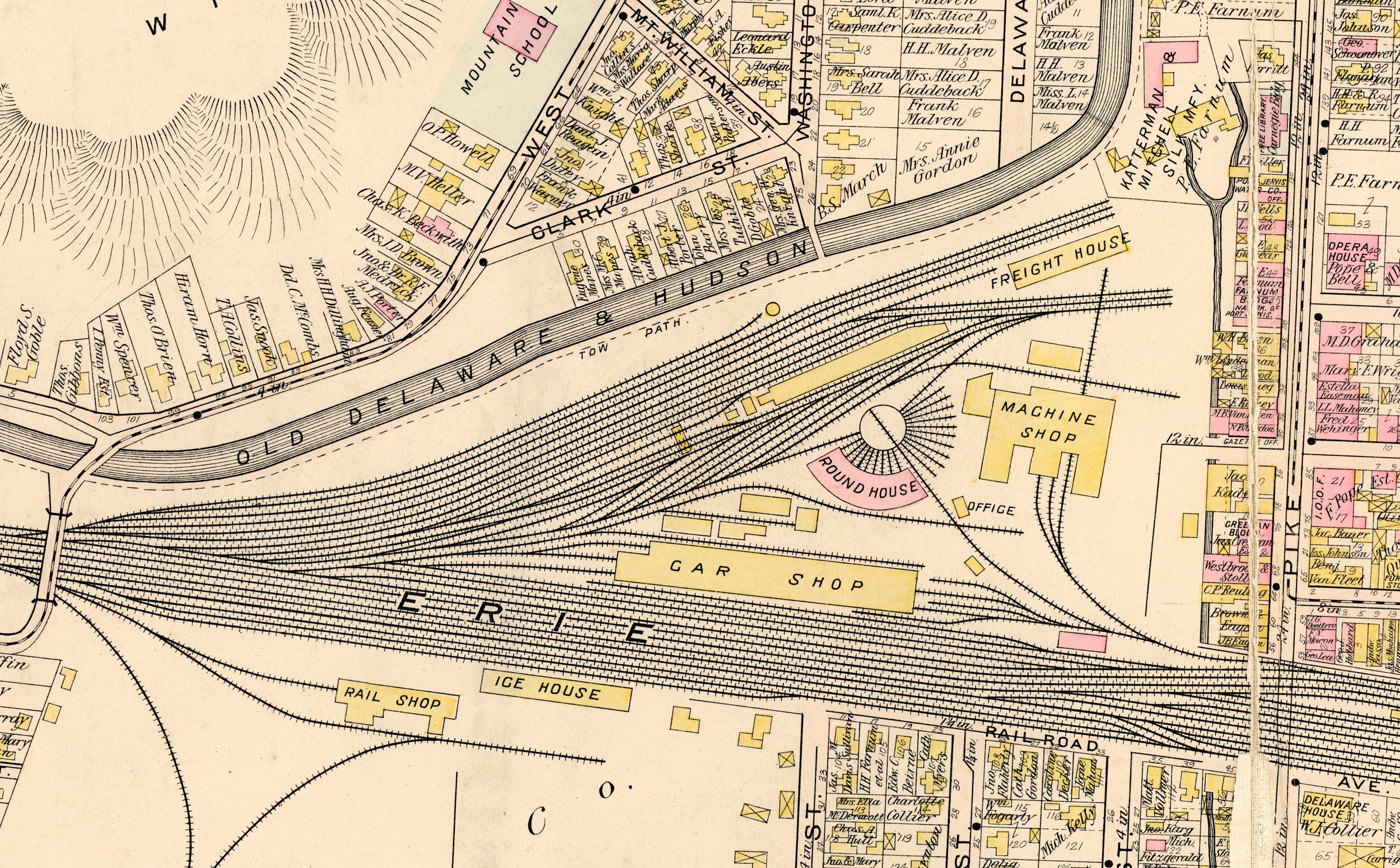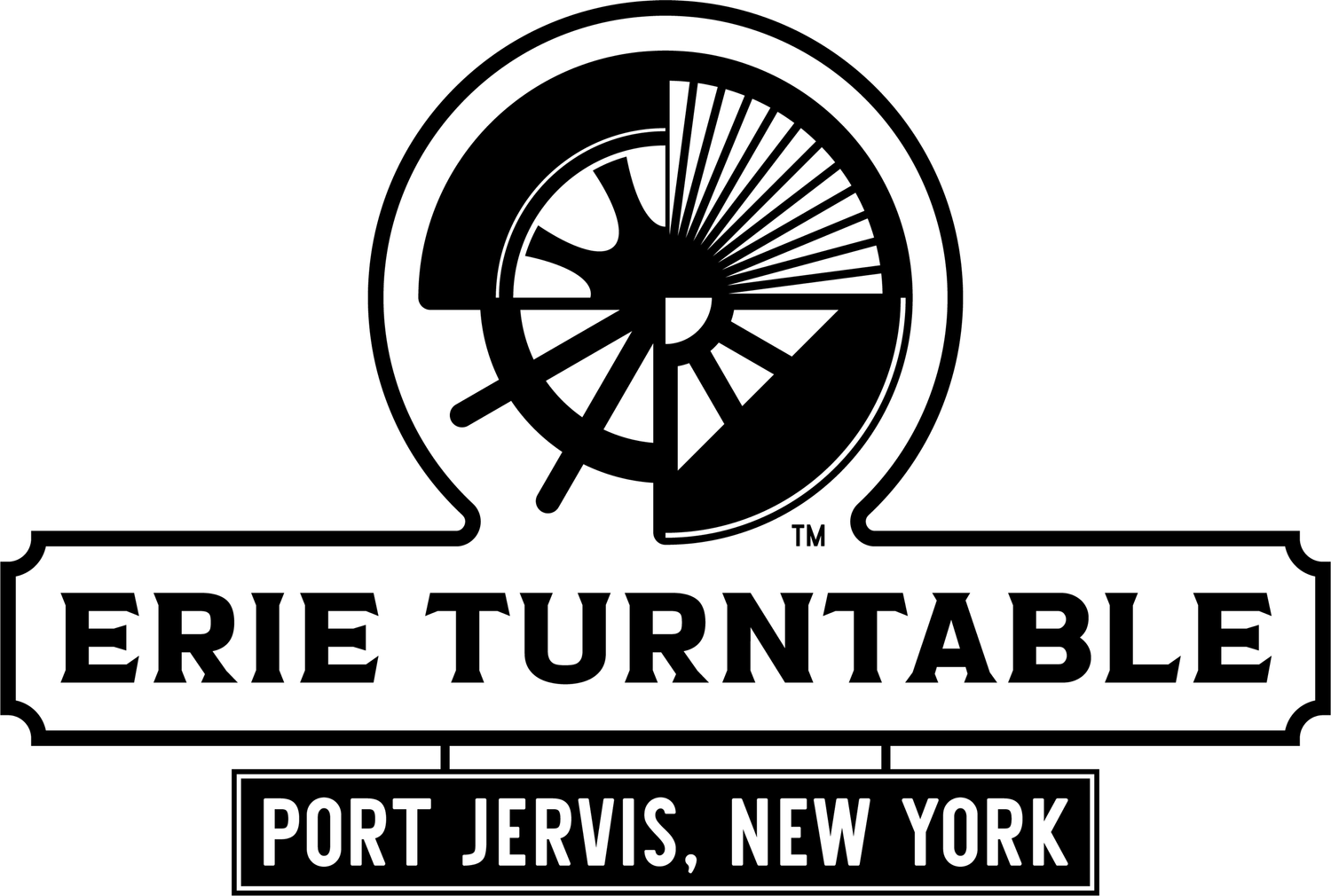
Site History
This page is an edited excerpt from the book The Railroads of Port Jervis, Volume 1: The Erie Railroad and Its Predecessors. The text is provided courtesy of author Rudy Garbely.
The New York & Erie Railroad (NY&E) was chartered on April 24, 1832 to traverse the entire state east to west, connecting the Hudson River at Piermont with Lake Erie at Dunkirk. Ground was broken in Piermont in 1835, and the route was completed and opened in stages westward.
By December of 1847, the tracks had reached a small, temporary terminal erected on the eastern bank of the Neversink River in Port Jervis. The route to Port Jervis was opened on January 7, 1848, connecting the booming town to the fledgling railroad network. Shortly thereafter, a bridge was built over the Neversink River, and the new railroad was extended through downtown Port Jervis and further westward, with the first trains reaching Binghamton by December 27th of the same year. The celebratory first NY&E train over the whole 446-mile route to Lake Erie operated from Piermont through Port Jervis on May 14, 1851.
As a major point of commerce along the Delaware & Hudson Canal and located at the corner of three states, Port Jervis was a logical location for the railroad to establish a significant presence. It was therefore selected as a major terminal on the NY&E, with locomotive and railcar repair facilities and a large sorting yard to handle the tremendous amount of freight anticipated for rail transportation in the region. The first turntable in Port Jervis was built in September of 1854 with a 30-stall half-moon wooden roundhouse, southwest of the present-day turntable near the modern Metro-North train station. Port Jervis became a division point, where the train’s crews would be changed to keep personnel working in familiar areas.
The railroad was reorganized on June 25, 1861 as the Erie Railway. Under the new company name, Port Jervis continued to grow as an important point for the railroad’s operations and locomotive maintenance, and activities quickly outgrew the original 1854 wooden roundhouse and turntable. In 1866, a full-circle 40-stall brick roundhouse and a 60-foot turntable were constructed adjacent to the original 1854 roundhouse on the site of the present-day turntable.
The railroad was reorganized again as the New York, Lake Erie & Western Railroad (NYLE&W) in June of 1878. Port Jervis was the NYLE&W’s main repair facility in the area, and its aging 1860s facilities needed to be modified to accommodate the new standard gauge equipment. The wooden 1854 roundhouse was removed entirely in the early 1880s, and between mid-1894 and the turn of the century, the brick 1866 roundhouse was partially torn down and the remaining 10 stalls were rebuilt. As the NYLE&W’s presence grew, so did the town of Port Jervis, becoming a “railroad town” where most residents worked either for the railroad or in industries that supported it. The Panic of 1893 forced the railroad to reorganize a third time, emerging as the Erie Railroad on November 14, 1895 with the backing of famed financier J. P. Morgan.
By 1922, the Erie was running 20 passenger trains a day to and from Port Jervis, and over 2,500 Port Jervis residents were employees of the railroad. Many other workers at the sprawling Port Jervis roundhouse complex traveled to and from the city via the railroad’s commuter trains. With the technological advancements of the Industrial Revolution came larger and more powerful locomotives, so circa 1906, the remaining stalls of the 1866 roundhouse were removed and a new roundhouse was built on the same site with a 90-foot turntable. It was replaced again circa 1927-1928 with a 115-foot turntable to handle the Erie’s new 2-8-4 locomotives.
With the railroad flush with cash following the war, it quickly adopted the latest in railroad technology – the diesel-electric locomotive – and set about replacing its entire prewar steam locomotive fleet starting in 1944. The last steam locomotive ran on the Erie Railroad on March 17, 1954. The coming of diesels largely negated the need for the sprawling roundhouses and servicing facilities required for steam locomotives, and about three quarters of the Port Jervis roundhouse and several support structures were leveled in the early 1950s.
After several years of cooperation with its longtime rival, the Erie Railroad merged with the Lackawanna Railroad on October 17, 1960 to form the Erie-Lackawanna Railroad (the hyphen was dropped in 1963). By 1970, the Erie’s Port Jervis freight house, located east of the turntable near Pike Street, was removed and the property was sold for the Save-A-Lot shopping center that now occupies part of the former roundhouse site. The Erie Lackawanna became part of Conrail on April 1, 1976, and the roundhouse site was taken over by this new railroad.
On January 1, 1983, commuter rail operations in Port Jervis were passed off to Metro-North Commuter Railroad, which expanded its Port Jervis commuter train storage and servicing yard in 1987 and wiped out many of the remaining vestiges of the Erie’s original servicing structures west of the roundhouse. Unfortunately, the surviving quarter of the circa 1906 Erie Railroad roundhouse in Port Jervis was destroyed by an arson fire on March 19, 1987. The remaining property around the old Erie shop facility, including the foundation of the burned roundhouse quarter, turntable, sand towers, and concrete coaling tower, was purchased from Conrail by City of Port Jervis in August of 1988, after which the site largely fell into disuse and disrepair. The coaling tower northwest of the roundhouse was demolished in the early 2000s due to safety concerns with the crumbling concrete. However, the original 1927-1928 turntable was restored to operation between 1996 and 1998 for the arrival of several steam locomotive excursions.
In early 2020, Operation Toy Train approached the City of Port Jervis to transform the city-owned Erie turntable site into an interactive historical display and event space. Some of the Erie’s original railroad tracks have since been restored to accommodate the display of this equipment. The original 115-foot turntable has also been restored again under the guidance of Erie Turntable volunteers. It is the largest operating railroad turntable in the eastern United States, forming the centerpiece of a new cultural center that traces its lineage back to the New York & Erie Railroad’s first construction at this site in 1854.
For more about the plans for this site in the future, visit our about page!
